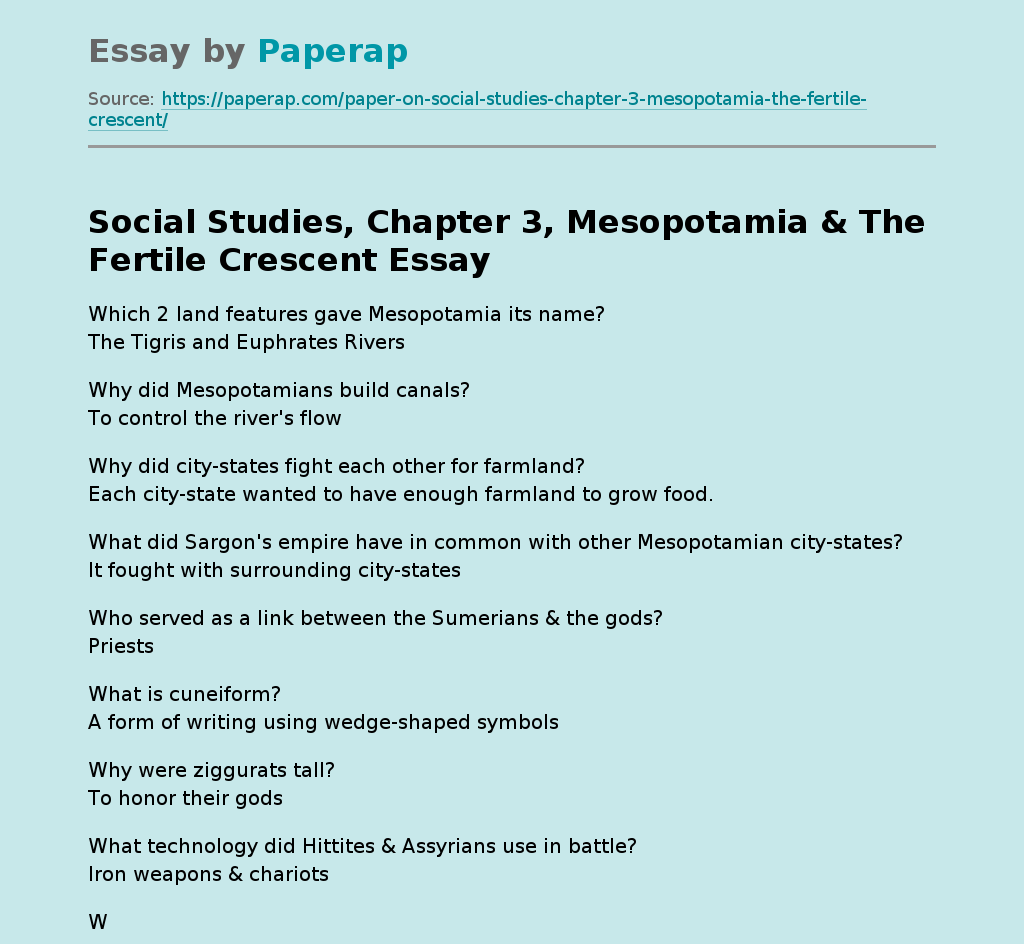Social Studies, Chapter 3, Mesopotamia & The Fertile Crescent
Essay,
Pages 3 (525 words)
Views
23
Which 2 land features gave Mesopotamia its name?
The Tigris and Euphrates Rivers
Why did Mesopotamians build canals?
To control the river’s flow
Why did city-states fight each other for farmland?
Each city-state wanted to have enough farmland to grow food.
What did Sargon’s empire have in common with other Mesopotamian city-states?
It fought with surrounding city-states
Who served as a link between the Sumerians & the gods?
Priests
What is cuneiform?
A form of writing using wedge-shaped symbols
Why were ziggurats tall?
To honor their gods
What technology did Hittites & Assyrians use in battle?
Iron weapons & chariots
What was the relationship between trade & the spread of the Phoenician alphabet?
The Phoenician alphabet spread along their trade routes.
The resource for which Phoenicia was well known
Cedar wood
Hammurabi and Nebuchadnezzar both
Built up Babylon
What factor may have limited the growth of Sargon’s empire?
The Syrian Desert did not have enough good farmland.
The army of SARGON
Defeated all city-states of Sumer and conquered Northern Mesopotamia
King GILGAMESH
Became a legendary figure in Sumerian literature
Sumerian city centers were dominated by
TEMPLES
Sharp REEDS
Used by Sumerians to make symbols on clay tablets
The city-state of UR
Rose to power after the death of Sargon the first
Hunter-gatherer groups first settled in Mesopotamia more than 20,000 years ago
False
The amount of land controlled by each city-state depended on its population.
False
Sumerian women could be important religious leaders
True
Sumerians developed a math system based on the number one hundred.
False
Babylon was located near present day Baghdad, Iraq
True
Fertile Crescent
A large arc of farmland
Irrigation
A way of supplying water to an area of land
Rural
Countryside
Polytheism
The worship of many gods
Social Hierarchy
A division of society by rank or class
Pictographs
Picture symbols used for written communication
Epics
Long poems that tell the story of a hero
Monarch
A ruler of a kingdom or empire
Chariot
A wheeled horse drawn battle cart
Alphabet
A set of letters that can be combined to form words
architecture
the science of building
Empire
land with different territories under a single rule
silt
a mix of rich soil and small rocks
surplus
more goods than are needed
priests
people who perform religious ceremonies
cuneiform
the world’s first system of writing
scribe
a writer
ziggurat
A pyramid-shaped temple tower
canals
Human-made waterways
Social hierarchy
a division of society by rank or class
city-state
A city and it’s surrounding country-side
the Hittities
the first group to rule after Hammurabi was
the Phoenicians
What People grew more powerful due to trade rather than from winning battles?
mountains to the east and west
Which natural obstacle led Phoenicians to use the sea for trade?
iron weapons and chariots
What technology did the Hittites and Assyrians use in battle?
Persian Gulf
Mesopotamia is an area of land between Asia Minor and the _________?
Sumerians
In Mesopotamia people called the ______ developed the world’s first civilization.
Sargon
The army of _____ defeated all the city-states of Sumer and conquered northern Mesopotamia.
Gilgamesh
A king known as ______ became a legendary figure in Sumerian literature.
reeds
Sumerians used sharp _____ to make symbols on clay tablets.
Social Studies, Chapter 3, Mesopotamia & The Fertile Crescent. (2018, Mar 12). Retrieved from https://paperap.com/paper-on-social-studies-chapter-3-mesopotamia-the-fertile-crescent/

